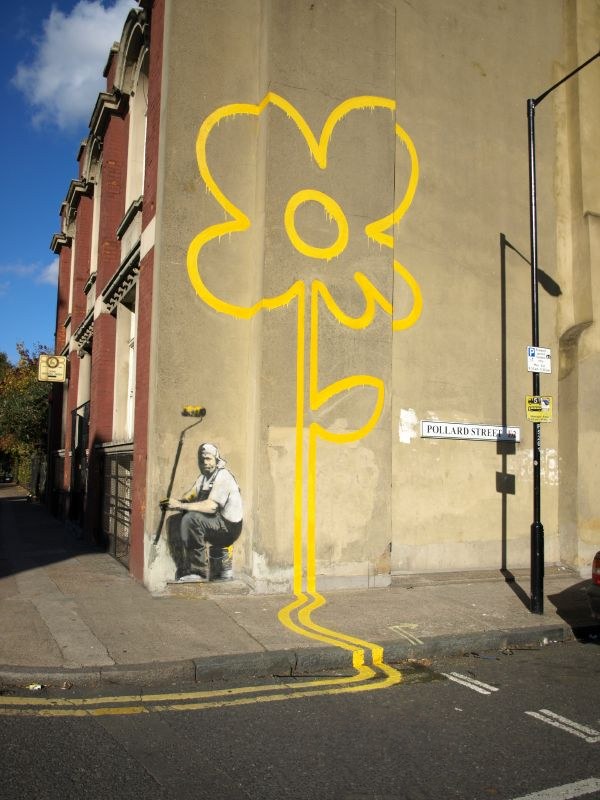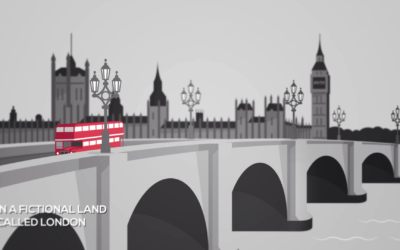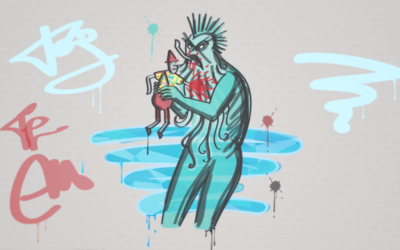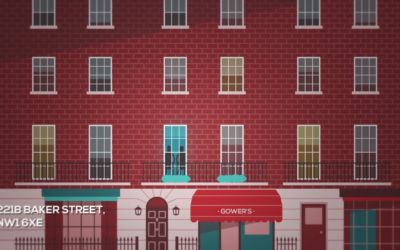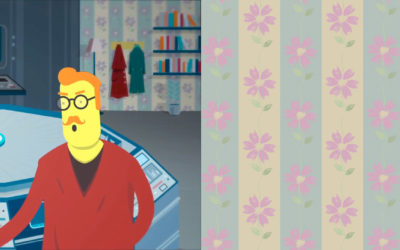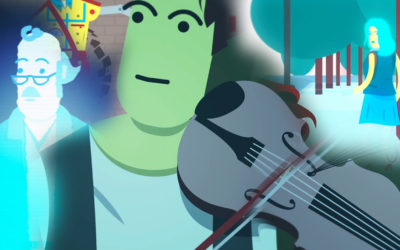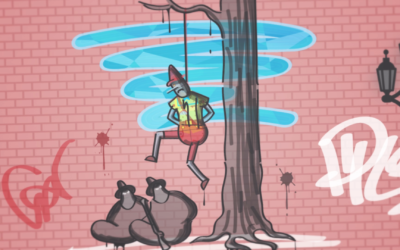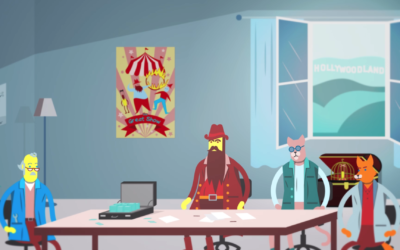8. THE DREADFUL IMAGES
The ‘dreadful images’ that scare Joseph, the toymaker, are graffiti drawn all over the ‘fictional land called London’. The illustration above, depicting Joseph’s toy hung from a tree, is based on an actual place in London: the corner of Pollard Street and Pollard Row, in Bethnal Green. This is where the English graffiti artist and political activist Banksy created ‘Yellow Lines Flower Painter’, one of his famous pieces of street art.
Graffiti and street art raises interesting questions about copyright. This Case File #8 explores when the law refuses to grant copyright protection to original work for policy reasons.
COPYRIGHT AND PUBLIC POLICY
Copyright protects different types of work, such as books, songs, films, as well as artistic works. In the UK, an artistic work is defined to include a graphic work, photograph, sculpture or collage irrespective of artistic quality, and graffiti is a type of graphic work.
However, just because the mysterious girl with the light blue hair has created original works of graffiti this does not necessarily mean they will be protected by copyright.
Historically, as a matter of public policy, the courts have refused to protect works which they considered to be immoral, obscene or irreligious. For example, in the early 20th century, one judge refused protection to an author’s dramatic work because it advocated ‘free love and justifies adultery’. He commented: ‘It is clear that copyright cannot subsist in a work of a tendency so grossly immoral as this.’
Today, that judge’s attitude seems rather prudish but the courts have recently reaffirmed that copyright will be refused to works that are ‘immoral, scandalous or contrary to family life,’ as well as to works that are ‘injurious to public life, public health and safety or the administration of justice’.
Lots of local authorities throughout the UK provide ‘free walls’ on which graffiti artists can create their works lawfully, but anyone caught doing graffiti on buildings and other public spaces without permission can be arrested and prosecuted under the Criminal Damage Act 1971. Also, the Anti-Social Behaviour Act 2003 introduced new powers for local councils to punish offenders and require them to help clear up any unwanted graffiti.
So, even though the graffiti in the video are original artistic works created by the mysterious girl, it seems they are also acts of criminal damage. For this reason, they may not be protected by copyright.
THE CASE: A-G v Guardian (No.2) [1990] AC 109
This case concerned the work Spycatcher written by Peter Wright (1916 – 1996) a former MI5 officer. The book was a part memoir, part exposé of MI5 and its operations.
The UK government tried to ban Spycatcher in the UK and prevent its publication elsewhere in the world, unsuccessfully. However, as Mr Wright’s memoir had been written in breach of the duty of confidence he owed to the Crown (his employer), he was denied copyright in his work. The House of Lords held that Mr Wright would not be able to bring an action for copyright infringement because of the ‘disgraceful circumstances’ under which the book had been written.
That is, it was not the nature of the content in the book but the circumstances under which the work had been created that meant Mr Wright could not enjoy copyright in his work.
FOR DISCUSSION: THE RIGHT POLICY?
Should works that are immoral be denied copyright protection? What exactly does it mean to say that a work is immoral? Or can you think what might be meant by works that are ‘contrary to family life’?
What about works created in breach of the criminal law or that are otherwise unlawful? Should unlawful graffiti be regarded as protected by copyright? What about the work of Banksy, and other underground graffiti artists. Is it in copyright or not?
USEFUL REFERENCES:
A-G v Guardian (No.2) [1990] AC 109 (the Spycatcher case) is available here.
You can find out the location of legal graffiti walls around the world here.
Download the PDF version of Case File #8 – The Dreadful Images.
More Case Files
1. The Red Bus
The Adventure of the Girl with the Light Blue Hair starts with a red double-decker bus travelling across Westminster Bridge, with the Houses of Parliament in the background.
2. The Monster
One of the graffiti that scare the toymaker Joseph portrays a monster eating his ‘beautiful, wonderful toy’. The image of the monster is inspired by two different artistic works
3. The Baker Street Building
Sherlock Holmes and John Watson discuss Joseph’s case at 221B Baker Street. The above illustration is inspired by two sources…
4. The Anonymous Artist
Joseph, the toymaker, has asked the police to identify the culprit making ‘dreadful images’ of his toy, portraying it in violent situations.
5. The Terrible Shark
This illustration from our video depicts a terrible shark-like creature about to eat Joseph’s toy. It was inspired by two different images…
6. The Famous Pipe
The pipe has been associated with the image of Sherlock Holmes since Sir Arthur Conan Doyle’s (1859 – 1930) stories were first published in The Strand Magazine with illustrations by Sidney Paget (1860 – 1908).
7. The Matching Wallpaper
In the background of Holmes and Watson’s apartment you can see wallpaper with ‘flowers scattered over it in a somewhat impressionistic style’.
9. The Improbable Threat
In trying to persuade Holmes to take Joseph’s case, Watson asks: ‘What if it’s a threat? That’s what the graffiti might mean.’ These eleven words are based on dialogue from The Blind Banker…
10. The Uncertain Motivation
Joseph, Sherlock Holmes and the Girl with the Light Blue Hair are all creators: Joseph draws and designs toys; Sherlock composes music; and the mysterious girl is an accomplished street artist.
11. The Mutilated Work
In trying to persuade Holmes to take the case, Watson argues that: ‘If you were a professional musician, you wouldn’t want people copying or mutilating your work’.
12. The Hollywoodland Deal
Joseph explains to Holmes and Watson when and why the dreadful images of his beautiful, wonderful toy began to appear all over London. When ‘some guys’ from Hollywoodland approached him ‘to option a movie’…

